James McAvoy Glass
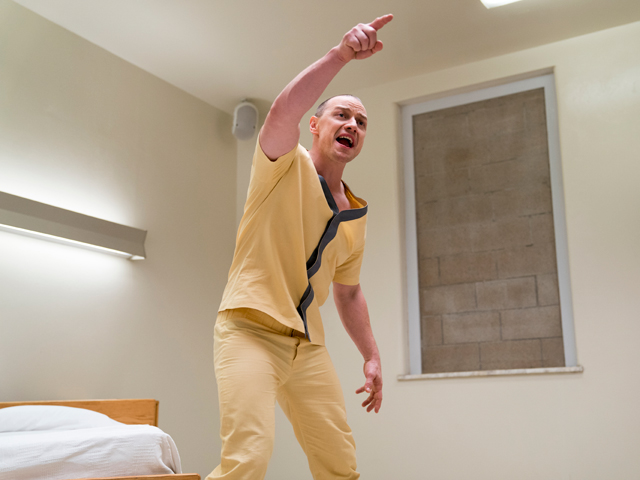
Following the Conclusion of Split
Cast: Bruce Willis, Samuel L. Jackson, James McAvoy, Sarah Paulson, Anya Taylor-Joy
Director: M.Night Shyamalan
Genre: Thriller
Rated: M
Running Time: 129 minutes
Synopsis: M. Night Shyamalan weaves together the unforgettable narratives of two of his visionary original films"2000's Unbreakable and 2016's Split"in one explosive, all-new comic-book thriller: Glass.
From Unbreakable, Bruce Willis returns as David Dunn as does Samuel L. Jackson as Elijah Price, known also by his pseudonym Mr. Glass. Joining from Split are James McAvoy, reprising his role as Kevin Wendell Crumb and the multiple identities who reside within him, and Anya Taylor-Joy as Casey Cooke, the only captive to survive an encounter with The Beast.
Following the conclusion of Split, Glass finds Dunn pursuing Crumb's superhuman figure of The Beast in a series of escalating encounters, while the shadowy presence of Price emerges as an orchestrator who holds secrets critical to both men.
Glass
Release Date: January 17th, 2019
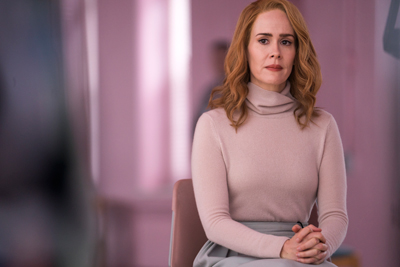 The Backstory
The Backstory
Evolution of a Trilogy
From Unbreakable to Glass
Long before he started making his 2016 smash, Split, M. Night Shyamalan intended for it to be far more than just an electrifying stand-alone film. The terrifying, breakneck thriller centers on Kevin Wendell Crumb (James McAvoy), a man with dissociative identity disorder whose more sinister personalities (collectively known as The Horde) kidnap three teenage girls. The plan is to feed the "impure" girls to another of Crumb's personalities, a superhuman creature known as The Beast. The final girl, Casey Cooke (Anya Taylor-Joy) is spared because The Beast sees scars covering Casey's body, markers of childhood abuse. Because Casey, unlike the other girls, has suffered, her heart is pure. "Rejoice," The Beast tells her. "The broken are the more evolved."
It was a riveting and powerful story on its own merits, but what no one outside of Shyamalan's inner circle knew, of course, was that the master filmmaker also planned for Split to exist in the same narrative universe of an iconic film he had made 16 years earlier - 2000's Unbreakable – and that Split would form the connective tissue of the most unprecedented and unexpected trilogy in film history.
Unbreakable, about a security guard named David Dunn (Bruce Willis) who becomes the sole survivor of a train wreck, posed the question of what would happen if superheroes were real. At the insistence of a mysterious, rare-comic-book collector named Elijah Price (Samuel L. Jackson), who suffers from a medical condition that makes his bones shatter on the slightest impact, Dunn comes to believe that he has super strength and is impervious to injury or illness. Not only that, he has the ability to see or sense the evil deeds of others simply by touching them. As Dunn accepts this new reality and begins to exercise his powers, he becomes a vigilante warrior, saving the innocent and punishing the criminal. He finds his true calling. In the film's final scene, Dunn goes to thank Price, but in a moment of physical contact between the two men, Dunn sees, to his horror, that Price has caused the train wreck that Dunn survived, and has committed other acts of terrorism that have killed hundreds, all in an attempt to find Dunn. Why? Because if Dunn is unbreakable and a superhero, and Price is Dunn's opposite, then Price, at last, knows for certain who he himself is: a supervillain, Mr. Glass.
In addition to its critical and commercial success, Unbreakable would prove to be an incisive, prescient, and almost-eerie cultural bellwether. Made years before the explosion of Marvel and DC superhero movies that dominate the industry today, the film became, and remains, a lodestar for comic-book fans worldwide. More than a decade after its release, Shyamalan was still routinely asked by reporters and fans if he ever planned to make a sequel. He always demurred. And, in typical Shyamalan fashion, when he finally did decide to do it, he did it in a way that no one saw coming.
The final scene of Split takes place in a Philadelphia diner, where patrons can be seen watching a news report that one of the kidnapped girls has survived but that Crumb is still at large. As the news report continues, we see a man at the counter in profile, and as he turns, we realize that it is David Dunn (Willis). Longtime Shyamalan fans lost their minds, speculating on what the scene might mean. Younger fans were left scratching their heads, at first. "Some of the teenagers were like, 'Who's that old guy in the diner?'" Shyamalan says, laughing. "But then they go and watch Unbreakable, and they fall in love with the tonalities of where it all started."
Shyamalan's vision was to create a trilogy unlike any before. "I want each film be a stand-alone in its power, in its language, in its originality," he says. And that the artistic whole of the trilogy exceeds the sum of its parts. "The three films honor each other as brothers and sisters," he says. "That would be the hope." Adds producer Ashwin Rajan, "It's two worlds, two previous films, colliding. Creatively, it's about tying those two worlds together seamlessly, both from a production standpoint and on a story level, to execute Night's vision."
Where Unbreakable examined a man whose modest self-image had blinded him to his own true power, and Split explored the lethal power of a monster created by a mind wounded by trauma, Glass delves into the root of identity itself: whether we are objectively who we are or whether our minds can shape and ultimately determine our physical realities. If you believe you're a superhero, are you one, even if your belief is a delusion? "I've been interested in psychology, and the psychology of therapy, since college, so those themes have been very organic," Shyamalan says. "Over time, the research and the story start feeding each other. With Split, I'd be reading about dissociative identity disorder, and then I'd think, 'Oh, that could be a great moment.' Unbreakable started the same way. I had snapped both of my ACLs in my knees from playing basketball and I had spent a lot of time in rehab and physical therapy. That informed the whole of Unbreakable."
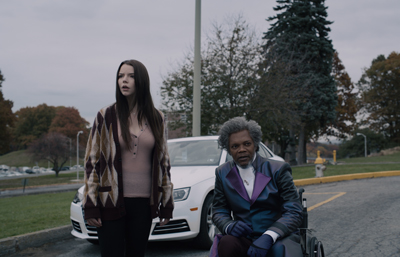 At the beginning of Glass, we discover that in the 16 years since Unbreakable, David Dunn has become a legitimate vigilante hero, known as The Overseer, protecting the citizens of Philadelphia full time with the help of his now-adult son, Joseph (Spencer Treat Clark). But Dunn is a controversial figure and is wanted by police. His success depends on maintaining his anonymity and staying one step ahead of the law. Crumb's sinister personalities, The Horde, meanwhile, have kidnapped four more teenage girls to feed to The Beast. Police have been unable to find them. Dunn needs to find Crumb, and fast.
At the beginning of Glass, we discover that in the 16 years since Unbreakable, David Dunn has become a legitimate vigilante hero, known as The Overseer, protecting the citizens of Philadelphia full time with the help of his now-adult son, Joseph (Spencer Treat Clark). But Dunn is a controversial figure and is wanted by police. His success depends on maintaining his anonymity and staying one step ahead of the law. Crumb's sinister personalities, The Horde, meanwhile, have kidnapped four more teenage girls to feed to The Beast. Police have been unable to find them. Dunn needs to find Crumb, and fast.
When he does, the epic battle will result in both Dunn and Crumb being captured and detained at Raven Hill Memorial Psychiatric Research Hospital under the forced care of Dr. Ellie Staple (Sarah Paulson), who specializes in a specific type of delusion of grandeur: people who believe they are comic-book characters. Notably, she has a third patient suffering from the same alleged affliction, a man who has been housed at Raven Hill for 16 years: Elijah Price. Price, now permanently in a wheelchair and heavily sedated, seems a shell of his former self.
As the three men grapple with their situation, they will be aided from the outside in various ways by Dunn's son, Joseph, Price's mother (Charlayne Woodard) and Casey Cooke (Anya Taylor-Joy), who has formed a singular, almost spiritual bond with Crumb, her former captor.
For Shyamalan, the joining together of these characters, from these two films 16 years apart, surprised him in unexpected ways. "I've never done anything like this," he says. "So it was very nostalgic for me. It represented a large section of my career, so I felt a great sense of emotion, and a great sense of urgency to do right by it," he says. "People are excited to see this movie because of their connection to one or both of the two movies, and that's a strange relationship to the audience I've never had before." Indeed, all of his films are original creations. He's never even made a sequel. "Usually people are coming to a movie of mine because I'm telling a story that seems intriguing to them and that they don't know much about. But this time, the audience has ownership. They have expectations. That's a really different process, and one I took seriously."
As a bonus, Shyamalan was able to incorporate never-before-seen footage from Unbreakable into Glass for scenes representing David Dunn or Joseph's memories. "It was amazing, because these scenes that we cut out of Unbreakable have always been in my head, and I was thinking these scenes could work into the movie if I wrote them in the right way," he says. "We were really excited to put them in the movie, and the audience can't believe what they're looking at. In one scene there's a boy, and then you see him at 25 years old in the very next scene. There's no CGI. That's really both of them. And it's the same thing with Bruce Willis. To see someone age eighteen years right in front of you is a powerful thing."
The story of Glass, producer Rajan says, "just feels epic. There's a poignancy and an inspiration to it." And the scale of the film, says fellow producer Marc Bienstock, is much larger. "Split was more contained, with the girls held captive in just a few rooms, and Glass is more expansive," Bienstock says. "The scope is bigger, and there's considerably more action."
Executive producer Steven Schneider says the result is a film unlike any ever made. "Every film Night makes is unique, and in this particular case, it's combining different genres into a wholly distinctive narrative," Schneider says. "It's something nobody has seen before. And the scope of it is massive. The gloves are off, and the stakes are very high, both for the characters as individuals and for the ultimate implications for society."
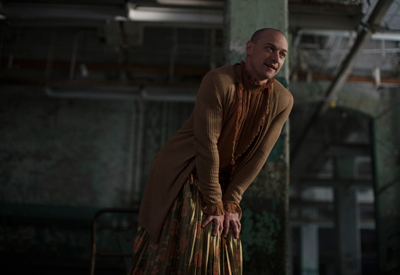 It's also a testament to the power of Shyamalan's cinematic vision, and the thrill of working with him, that every actor from both films agreed to resurrect their roles for Glass. "Unbreakable and Split were both, in a way, deconstructionist superhero movies," McAvoy says. "Split didn't even feel like a superhero, or super villain, movie at all. It was just this creepy, scary movie that only really revealed itself at the end as having anything to do with 'super people.' That's exciting because I'm in super hero movies myself with X-men, and I love them, but we can't just keep telling straight-up super hero movies can we? We've got to start putting superheroes in different environments and situations, and this film certainly does that."
It's also a testament to the power of Shyamalan's cinematic vision, and the thrill of working with him, that every actor from both films agreed to resurrect their roles for Glass. "Unbreakable and Split were both, in a way, deconstructionist superhero movies," McAvoy says. "Split didn't even feel like a superhero, or super villain, movie at all. It was just this creepy, scary movie that only really revealed itself at the end as having anything to do with 'super people.' That's exciting because I'm in super hero movies myself with X-men, and I love them, but we can't just keep telling straight-up super hero movies can we? We've got to start putting superheroes in different environments and situations, and this film certainly does that."
For Charlayne Woodard, it's Shyamalan's appreciation and admiration for actors, and what actors do, that sets him apart, and that makes actors willing to go to any length to help realise his vision. "Night loves artists," Woodard says. "One day on set I heard him refer to a certain actor. He said, about her, '… she's a Stradivarius.' Night compares artists to the best violin ever made, believing that we can play anything and everything. It doesn't get any better than that. He's marvelous."
The Characters
Kevin Wendell Crumb/The Horde
James McAvoy
Kevin Wendell Crumb is one of the most fascinating, terrifying, complex and wounded characters any actor could play. With 23 distinct personalities, Crumb is a role that requires an actor with range, nuance and subtlety, because under the monster that is The Beast, and the domineering personalities such as Dennis and Patricia that make up The Horde, is the subsumed character of Crumb himself.
"Kevin is a guy who was abused horribly by his mother and as a result his mind fragmented and dissociated. From that 23 other people were born," McAvoy says. "He is somebody who has been in a kind of coma for large periods of his life while other people have being conscious in his body. He's one of the many that live in the body that used to be just his."
"I think of The Horde as a collective, some good people and some bad people. I don't think of any of them as truly evil, but as people who are involved in doing bad things, and there are reasons why they're doing them. Are there reasons why they deserve to be captured and incarcerated and possibly punished? Probably. But does that make them bad? I don't know about that."
In Glass, Crumb is confined in a cell that has been outfitted with a kind of strobe, a hypnosis light. If one of his threatening personalities emerges, the strobe will activate and trigger a different personality to replace it. The Beast within him has battled David Dunn to a stalemate and wants to destroy Dunn. He wants to be free. But not all of Crumb's personalities believe in The Beast, and some are questioning whether Dr. Staples' hypothesis – that The Beast's super powers are merely a psychological delusion – may have some truth.
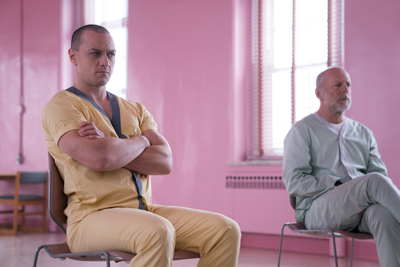 "Playing Kevin is overwhelming because he finds the whole world overwhelming," McAvoy says. "He doesn't want to be alive, so it's exceptionally sad playing Kevin." His other personalities present their own challenges. "It's really about time management, because doing prep for that many characters is a lot," he says. "But the work is the same work I do when I'm playing any character: What does this character want? How do they go about getting it? What are the things stopping them from getting it? You do all your background work just like you always do. It's just about trying to do tons of it."
"Playing Kevin is overwhelming because he finds the whole world overwhelming," McAvoy says. "He doesn't want to be alive, so it's exceptionally sad playing Kevin." His other personalities present their own challenges. "It's really about time management, because doing prep for that many characters is a lot," he says. "But the work is the same work I do when I'm playing any character: What does this character want? How do they go about getting it? What are the things stopping them from getting it? You do all your background work just like you always do. It's just about trying to do tons of it."
In one scene in Glass, McAvoy has to transition through multiple characters in a very short period of time. "That becomes tricky, when you have to transition from one to the other to the other on-camera," he says. "You have to be able to commit fully to the next person whether that person in the same emotional space as the last one. So you can get yourself in a place of hysteria or deep sadness or panic, and then the next personality has to be super calm and in a good mood and jovial. That's quite hard because your heart rate is physically different to what it should be when you go into the next character. It's like sudden gear changes."
But the most physically demanding part of the role, by far, is playing The Beast. "He's so physically tense and on the edge of pouncing because he's so animalistic that I find it hurts me, physically, to play him," McAvoy says. "After I play him for a few days, my collar bone and neck are killing me for days afterward. On Split it didn't matter as much because I only did it for a couple of days for that shoot, but this time I'm playing The Beast a lot more frequently."
One of the biggest changes from Split to Glass was the age of the cast. In Split, McAvoy was one of the oldest members of the principal cast. This time he's younger than his two main co-stars. "On Split I sort of felt like a granddad," he says. "This time, I feel younger because more senior people are around me. And working with Samuel L Jackson and Bruce Willis… that's just proper nuts. Having watched and admired their movies when I was younger, getting to work with them is strange, brilliant and fun."
For his Split and Glass co-star Anya Taylor-Joy, watching McAvoy play this role has a different emotional impact. "Kevin breaks my heart," Taylor-Joy says. "I walked into my house the other day and my parents were watching Split on TV. I walked in just at the moment in the movie where we meet Kevin and I burst into tears. He's the person that Casey really connects with. He's a mirror to her, and I think the relationship that the two of them have is so pure and so tender. Kevin's a really wounded soul and somebody that needs protecting. That's why the alter personalities came; they came to protect him."
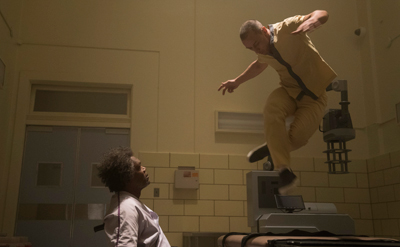 David Dunn/The Overseer
David Dunn/The Overseer
Bruce Willis
In the 16 years since the events of Unbreakable, David Dunn has lost his wife to cancer, has created his own security business with his son, and has devoted himself to fighting crime as a vigilante called The Overseer. But the cost of all that has been high, and the price of all that history is reflected in Bruce Willis's performance. "Bruce is the most chilled dude," McAvoy says. "He is so relaxed, but he's bringing such a heaviness to the part. That's beautiful, and something I haven't seen a lot in a superhero movies: the weight, the toll that the work takes on them. And it's expressed so brilliantly by Bruce. His natural laidback-ness translates into something really sad in the character. David Dunn is this lonely man. All he really has in his life is his vigilante purpose and his son, and that's kind of it. There's such a purity and sadness in what Bruce is doing with that."
Willis welcomed the opportunity to revisit the character, and to reunite with Shyamalan. "It was fun to come back and tell the continuation of this character's story so many years later," Willis says. "Rarely, if ever, does an actor have an opportunity like this. Night creates characters that are unique and memorable and feel personal. I was just as thrilled to play David Dunn as I was the first time I played him."
When Dunn decides to pursue The Beast, it is with the sense that only he can stop him, and the burden continues to weigh on him after the two men are hospitalized together at Raven Hill. Dunn's weakness, his kryptonite, is water, and so Dr. Staple has rigged Dunn's isolation room with a massive water rig that will instantly flood the room if Dunn tries to escape. As Dr. Staple attempts to treat Dunn for his alleged delusion, Dunn's only concern is protecting everyone in the hospital, and the public in general, from The Beast. He's a man worn down by the burden of his superpowers, but he also can't find a path away from it. If Dr. Staple is right, it could be, in a way, a relief, even if he can't quite bring himself to believe her.
For his fellow cast members, working with Willis was a singular experience. Jackson has worked with Willis on multiple films, including Pulp Fiction, and the two veteran actors have developed a natural ease to their working relationship. "I always enjoy working with Bruce," Jackson says. "He's a very familiar and easy character for me to fall into, and to fall into patterns with."
That sense of familiarity was also felt between Willis and his director, who were making their third film together. "Working with Night on The Sixth Sense, we had a really good time shooting that movie and developed a friendship and a high level of trust," Willis says. "When he told me that he had an idea for a script for me, which was Unbreakable, I immediately said, 'OK, I'm in.' I didn't even know what the subject matter was going to be. Similarly, when he approached me about Glass, I agreed immediately, I didn't have to read the script. To be able to work again with Night as a friend and collaborator was a dream come true."
For Spencer Treat Clark, the opportunity to revisit the father-son roles that he and Willis portrayed in Unbreakable, now from an adult perspective, made a deep impact on him. "Night and Bruce have so many great stories about each other and about Unbreakable that I really didn't know about before; it is so weird having the adult prospective now about that experience," Clark says. "They have a really cool relationship; it's like a big brother, little brother relationship. We had a dinner at Night's right before we started shooting, and Night has a room in his house with memorabilia from all his previous films. It was wild walking through that, with Bruce reflecting on his experiences and Night on his. We were all starting to get pretty excited for the weeks and months ahead."
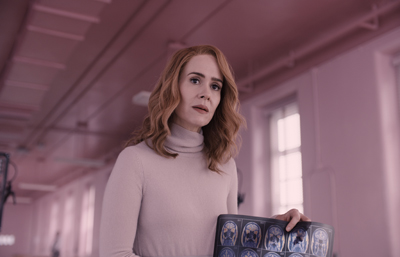 "Unbreakable was a pretty pivotal experience for me growing up, and it was fun going back and looking at Joseph, and my experience playing him, and how he's evolved. I got two really cool set gifts at the end of Unbreakable. One was from Bruce. He gave me the complete CD box sets of Led Zeppelin and the Beatles, which is super cool. Those CDs got so much use. I wore through them through my Discman all through my early teens. I started playing music because of those, started playing the guitar and I became a musician."
"Unbreakable was a pretty pivotal experience for me growing up, and it was fun going back and looking at Joseph, and my experience playing him, and how he's evolved. I got two really cool set gifts at the end of Unbreakable. One was from Bruce. He gave me the complete CD box sets of Led Zeppelin and the Beatles, which is super cool. Those CDs got so much use. I wore through them through my Discman all through my early teens. I started playing music because of those, started playing the guitar and I became a musician."
Casey Cook Anya Taylor-Joy
When we first re-encounter Casey Cooke in Glass, it has been three weeks since she escaped from Kevin Crumb's most lethal alter, The Beast. "Casey is a girl who went through something that no one should ever have to go through," Taylor-Joy says. "But she's resilient; she bounces back. In this movie we find her and she's quite different than she was in Split. Her experience was terrifying, but it gave her the permission to be herself and to stop blaming herself for a lot of things."
She's back in high-school where (coincidentally?) David Dunn's son, Joseph, went to school. She is no longer the victim of her abusive uncle, and her status as the sole survivor of The Beast has made her a subject of fascination to her peers. She is finding her own voice, strength and power. For Taylor-Joy, that was a significant change from Casey in Split, where she was in fear for her life, and trapped in a warren of small rooms the whole time. At first, Taylor-Joy wasn't quite at ease with the new Casey. She had to almost re-discover her, in a way.
"What I found semi-uncomfortable was being Casey without the confines of the room," she says. "In a high-pressure situation you act differently. I had to understand who Casey was now. I had a bit of growing pain within myself, but now I feel very comfortable with her, and it actually gives me a lot of peace to understand her in a new way."
"I have such an intense connection with my character that there was an element of being a bit scared," Taylor-Joy says. "The first day on Glass, it felt so strange to make that jump because it's only three weeks after the events of Split and Casey is different. It was a little surreal. But I came to feel grateful for it because the character and I got to have a more decent parting. Without that, I would never have known where she went. I also had no idea if Casey and Kevin would see each other again, so my first scene with James [McAvoy] was really emotional, actually."
In the film, Casey becomes an advocate for the hospitalized Kevin Crumb. Despite his disorder, he was the first person who saw Casey clearly and recognised her pain. She, in turn, has recognised his. "Both of these characters are so broken and have been so hurt that they together have this bond," Taylor-Joy says. "They're kindred souls."
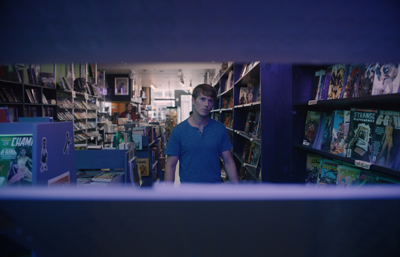 Dr. Ellie Staple
Dr. Ellie Staple
Sarah Paulson
The most prominent new character of the trilogy is Dr. Ellie Staple, a renowned psychiatrist who specializes in patients suffering from the delusion that they are comic-book characters. She has developed an experimental medical procedure to rid the patients of their delusions, but it does not leave them entirely unscathed.
That complexity in Dr. Staple required an actor who could not only hold her own against three strong characters (and actors) in Price, Crumb and Dunn, but also an actor of great emotional depth. Shyamalan found that ideal actor in Paulson. "I wanted someone who could match those three men in craft, and also in buoyancy and entertainment," Shyamalan says. "I also needed someone who could match them in intelligence, and really own the screen against these three superstars. Sarah was chosen to fight that fight and boy, did she deliver."
Paulson was eager to dive into the character. "Ellie is a doctor of incredible compassion who has a deep-seated belief that her way of thinking is an answer to some of the world's problems," Paulson says. "Not everybody is on board with that, but I can get behind her reasoning for the things that she does."
This involves elaborate systems to keep Crumb, Dunn and Price contained and controlled. As empathetic as Dr. Staple seems, she is also driven by her own ambitions and desires to establish a psychiatric breakthrough that will set a new benchmark for her profession. The question is, is she fixing these men, or breaking them?
"The overarching questions of this movie are, what do we all have inside of ourselves? Is it good to believe we're capable of anything and everything? Should we doubt? How much gravity do you want to give to your own belief?" Paulson says. "That internal thought process is interesting to ponder. This movie is not set in a fantasy world. It's reality. So what happens when you really have a belief that you have super powers, and that you might be superhuman?"
What makes Dr. Staple so compelling as a character is that she's not just clinical, but has a strong emotional intelligence and compassion. "It's a very fine line between her clinical manner and her need for order and her ability to become incredibly connected to the person she's talking to," Paulson says. "She's incredibly empathic, and that is the thing Night wanted her to lead with, so that she doesn't become sort of a typical, clinical doctor. She's a human being who is deeply affected by the people she's sitting across from."
In one of the film's most fascinating scenes, Dr. Staple is questioning Kevin Crumb as he cycles through personality after personality in a matter of minutes. "It was impossible for me not to sort of shudder in awe every time James moved in and out of a different character," Paulson says. "From an acting standpoint, it was incredibly inspiring, and I was able to use some of that emotional response for Dr. Staple, to have her be moved by what she is witnessing."
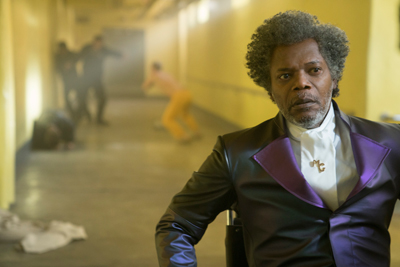 Elijah Price/Mr. Glass
Elijah Price/Mr. Glass
Samuel L. Jackson
Since we last saw Elijah Price proudly confess to his crimes at the end of Unbreakable, and declare himself the supervillain Mr. Glass, he has been housed at Raven Hill hospital in the psychiatric ward. Now in a wheelchair permanently, he has been heavily sedated for much of his incarceration there in an attempt to keep his mesmeric intellect contained. Early in his stay there, he had managed to shut down the hospital's entire electrical grid.
When we first see him in Glass, he's a shard of his former self, a dead-eyed blank who doesn't even acknowledge that his mother is in the room, much less answer her questions. But it soon becomes clear that there is more going on behind those eyes. "He's pretty much the same guy," Samuel L. Jackson says. "Elijah is still very calculating, he's still very watchful, he's still strong. He has just been isolated, which has given him a lot more time to formulate opinions, formulate plans, and to dig in to what he believes even further."
The arrival of Dunn and Crumb presents Price with a prime opportunity to not only liberate himself, but to liberate the culture by exposing the truth that superpeople walk among us. This puts him in direct opposition to Dr. Staple's belief that the men are deluded. What makes Price so dangerous, of course, is that no one knows what he's up to. Until, that is, it's too late.
"Elijah has been living with pain " relentless, chronic pain " since his birth," says Charlayne Woodard, who plays Price's mother. "This has affected him in extraordinary ways. I won't say he's evil. I won't say he's good " because aren't we all both, really?"
Indeed, one of the film's most clever narrative devices is gradually shifting our perceptions of Price. The character doesn't change, but we begin to see him in a new light. "The idea of having a marginalized character that is your hero, who is the title character, is very satisfying for the audience," Shyamalan says. "You really want him to succeed, even if some of the things he's doing are dastardly."
Mrs. Price
Charlayne Woodard
When we first meet Mrs. Price in Unbreakable, she is the tough-love mother of a pre-teen Elijah Price. His genetic illness, osteogenesis imperfecta, has caused his bones to break so easily that young Elijah has become housebound. He's afraid of the world. But he loves comic books, and his mother forces him to leave the house by routinely placing a new comic book on the bench in the playground across the street from their home. She coaxes him back into the world.
Now, in Glass, her son is so heavily sedated he seems to almost not exist, but she is determined not to give up on him and believes that he is still inside there, somewhere. He just needs to right motivation to come out again.
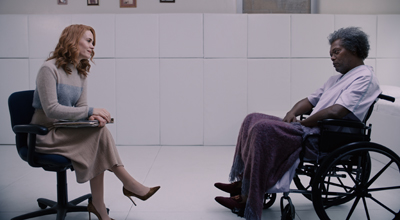 "Elijah Price is my baby, and we've had a tough time of it, but we're survivors," says Charlayne Woodard, who reprises her role as Mrs. Price in Glass. Returning to the role has been a joy, she says. "It's wonderful for me, because 17 years ago I was playing an older woman, and now I am legitimately an older woman. Experience has 'growed me up.' I come to Mrs. Price with a little more knowledge, and a little more courage."
"Elijah Price is my baby, and we've had a tough time of it, but we're survivors," says Charlayne Woodard, who reprises her role as Mrs. Price in Glass. Returning to the role has been a joy, she says. "It's wonderful for me, because 17 years ago I was playing an older woman, and now I am legitimately an older woman. Experience has 'growed me up.' I come to Mrs. Price with a little more knowledge, and a little more courage."
For Woodard, filming Glass was also an opportunity to catch up with people she hadn't seen in almost two decades. Because Shyamalan's crews are so loyal, and because he's so loyal to them, the set of Glass sometimes felt like a family reunion. "Night creates such a lovely work environment," she says. "You can tell that he really cares for actors and his crew. The set is a family, period, the end."
Joseph Dunn
Spencer Treat Clark
The son of David Dunn, Joseph is now 25 years old and runs Dunn Security with his father. In Unbreakable, Joseph, then 9, was the first true believer that his father had superpowers. He still believes in his father, and has become David's partner in vigilante crime fighting, helping him locate criminals, monitoring his father's activities remotely via camera, and communicating with his father through an earpiece during his missions. In many ways, Joseph has become his father's protector, assessing the risk of various situations and also staying wary of the police, who are on the hunt for David. His father's incarceration at Raven Hill will test Joseph's ability to do that, and he will be forced to question his belief in his father's powers.
For Spencer Treat Clark, the opportunity to resurrect a role he played as a child was a gift, and one that stunned him. "It was pretty unbelievable, the whole thing," Clark says. "When Split came out I was on a camping trip with my friends and had my phone on airplane mode. When I got back I had, like, 15 texts from people asking me if I'd seen it. So I went, and at the end, when I heard the Unbreakable score and then saw Bruce, and I was like, 'Huh?'" I really had no expectations, and when I had a call with Night, I was pretty sure it was going to be a courtesy call to tell me they had hired Chris Hemsworth to play Joseph. But he said he had a role for me, and two months later I got the script. It was crazy."
It also surprised him how substantial and pivotal the role of Joseph is in Glass. It was a much larger part than Clark had anticipated. "I more or less said yes before I read the script, which gave my agents zero latitude to negotiate," he says, laughing. "Night probably could have dressed me up in a clown costume and stuck me in a corner for the whole movie and I still would have been down."
One crucial side benefit of the role for Clark was the opportunity to reconnect with Shyamalan, who had been a mentor to him on Unbreakable. "Night was a big influence on me," he says. "He was somebody who was successfully pursuing the arts and he was young, too. At the time, he was a couple of months younger than I am now, which is crazy to think about. I have incredible pictures of us both from that time, both looking like babies."
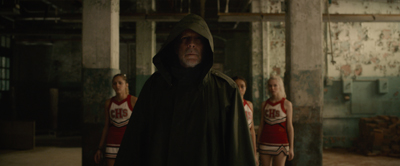 Locations And Filming
Locations And Filming
Brick Warehouses and Abandoned Hospitals
The Search for Glass architecture
As with almost all of Shyamalan's films, Glass was shot in and around Philadelphia, Pennsylvania. The two most critical locations that Shyamalan needed to find were a brick warehouse, where The Beast is holding the cheerleaders he intends to kill and where The Beast and David Dunn engage in an epic brawl, and a building that could become Raven Hill hospital, where most of Glass takes place.
To find the perfect locations, Shyamalan asked location manager Staci Hagenbaugh, with whom he'd worked on his films The Happening, The Visit and Split, to begin the search.
"We probably scouted at least 25 potential brick factory options before we landed on one," Hagenbaugh says. "We were down to two, and ultimately the Frankford Arsenal, a former 19th century Army ammunition plant in northeast Philadelphia, was the one that won. That location was going to have so many different things going on: a lot of stunt work, a lot of visual effects work, and everything happening at the same time. Plus, there's a lot of interior and exterior interplay in that scene. Night was very adamant that he needed the exterior and interior to be able to work together. For me it was such an iconic location to be at because it hasn't been shot for a very long time. We were really excited to be there."
Sadly, that did not mean that shooting there was much fun for the actors, primarily because it involved a massive fight scene in the rain. "The action sequences in this movie are really on another level," says executive producer Schneider. McAvoy puts it in more concrete terms. "Being in the rain and doing the stunts at the brick factory, it was fun," he says. "But you're playing someone who's impervious to cold and you're standing in freezing rain with your shirt off going, 'I'M The Beast!,' When what you really feel like is a wimp who is freezing and whose nipples are harder than diamonds."
Making matters worse, McAvoy had to attack Willis while Willis was wearing a camera rig. "So Bruce had a camera on steel poles, and the poles were coming out the back of his costume," McAvoy says. "But thankfully Bruce is a gentle giant. He was lovely."
To find the location for Raven Hill Hospital, Hagenbaugh had an inside track on one that might fit the bill. "I had worked with the Commonwealth of Pennsylvania before at a couple of their facilities, and I'd known that Allentown State Hospital was closed for a few years, but I had never seen any photos of it," she says. "As soon as I took one look at it, I knew that Night was going to love it for his movie." She sent him the photos that a colleague of hers had taken. "Within five my phone rang and Night was like, 'What is this place? We have to go see it!' A couple of days later we were there and that was that. He's such a visual person, and I think there was an immediate connection to the location once he walked inside."
It was so perfect, in fact, that it helped shape the film itself. "We found the hospital so early that Night was able to do some revisions to the script and write to the location, and to really tailor, visually, what was happening in the space," says producer Bienstock.
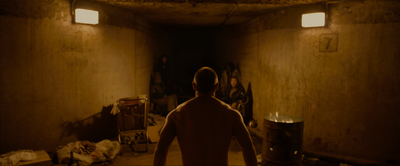 Shyamalan and Hagenbaugh spent a few days exploring the hospital, which had been a psychiatric hospital from 1913, when it opened, until it closed in 2010. At its peak in 1950 it housed more than 2,000 patients. "We started making a list of which areas he really wanted to put in the movie," Hagenbaugh says. "He found some areas that he loved and then wrote scenes especially for them."
Shyamalan and Hagenbaugh spent a few days exploring the hospital, which had been a psychiatric hospital from 1913, when it opened, until it closed in 2010. At its peak in 1950 it housed more than 2,000 patients. "We started making a list of which areas he really wanted to put in the movie," Hagenbaugh says. "He found some areas that he loved and then wrote scenes especially for them."
One room that provided a particular bit of inspiration was a former day room for the patients. "It was painted a bright Pepto-Bismol pink; it was pretty incredible," Hagenbaugh says. "Night and Ashwin and I looked at it, and Night really responded to it, but there were some difficulties with actually shooting that room. So we ended up replicating that same look, that same pink room, in a room one floor below it."
Indeed, it became perhaps the most pivotal room in the hospital, the room where Dr. Staple meets with Dunn, Price and Crumb together for their group sessions.
In some ways, the hospital itself set the tone for the entire film. Because it was the first location selected, Hagenbaugh says, it determined the visual direction of everything else. "We wanted all locations to have that same kind of vibe," she says. "Just a little bit eerie."
The cast and crew definitely felt that eerie vibe while shooting at the hospital. "That's a spooky place to shoot," Jackson says. "Sometimes, going from the set to the bathroom, you had to do a lot of long walks by yourself down those hallways, make some turns and do some twists. It's a little creepy in there."
The Production Design
Color, Claustrophobia and Character
Crafting the Glass Universe
For production designer Chris Trujillo, the Allentown State Hospital also helped guide the overall look of the film. "To go into those big, old derelict facilities and see all of that turn-of-the-century grandeur is incredible," he says. "And the fact that it was designed for the purpose of a mental health facility is also really interesting. It gave us insight into what that world looked like."
The holding rooms for each of the three main characters – Dunn, Price and Crumb – had to be both visually in sync with the design of the overall hospital, but also be retrofitted to control each man's particular powers. Character and story drove design. "Each room is tailored to who each of those men is," producer Rajan says. "David Dunn, who has a weakness for water, is in a room with a water system that can spray water at him if he tries to escape. The Horde [Crumb] is in a solitary room with lights that can control his personality changes, and Mr. Glass [Price] is in a padded room so that he's not able to break his bones. The rooms each have a personality, given the character."
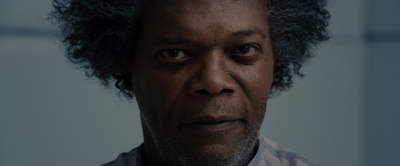 Dunn's water-system room was particularly challenging to design, Trujillo says. "It was a lot to conceptualise, to figure out how to make that set really interesting and striking but also believable. The materials had to exist in the real world, and it had to be something that could conceivably be created." The results speak for themselves.
Dunn's water-system room was particularly challenging to design, Trujillo says. "It was a lot to conceptualise, to figure out how to make that set really interesting and striking but also believable. The materials had to exist in the real world, and it had to be something that could conceivably be created." The results speak for themselves.
In general, Trujillo wanted to employ a subtle design aesthetic, but to use color in very specific and strategic ways. "There's a very clear color theme running through all of the sets and the costuming," Trujillo says. "The color quality is very specific in places so that the audience knows our intention. One space may have a desaturated, almost claustrophobic vibe and another may be more saturated, a little louder color. We're trying to be very specific about what we're suggesting about the psychology of the characters, based on the color of the spaces. That's very deliberate."
Nowhere is that more evident than in the room where Dr. Staple treats Dunn, Crumb and Price together, in a sort of superhero group-therapy session. "It's this enormous, fabulous room that is monochromatically in pink tones," Trujillo says. "That was a little counterintuitive for me, but Night was very confident about it, and it's pretty incredible. It's this hypnotic, Kubrick-ian, bizarre room. That was a lot of fun."
The Costumes
Purple, Green and Gold
Designing a Perfect Palette
One of the greatest challenges facing costume designer Paco Delgado was merging the palettes and visual styles of two movies made 16 years apart, and to also create an aesthetic specific to Glass. "We are mixing two different stories: the story that was told in Unbreakable and the story that was told in Split," Delgado says.
"That's complex because you have to stick with a certain palette. Historically, each character has a distinct wardrobe color. David Dunn wears green, Mr. Glass is purple, and The Horde is yellow. So for Glass, we had taken all three colors from all the movie palettes. And that means you end up with a limited palette for the rest of the characters in the film. On the positive side, it gives you a very clear color path to follow."
"We have these characters who, apart from being superheroes, lead normal lives. We tried to find the balance where the superhero starts and where the human being finishes. It's two sides of the same character. For example, when we want to dress David Dunn, we stick with the green palette, but it's much more subtle than when he's wearing the green poncho. It's the same for the other characters."
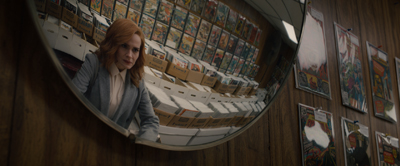 Those three colors – green, purple and yellow – extended into the looks of each man's family member or surrogate family member. This created a visual connection between David Dunn and his son, between Price and his mother, and between Crumb and Casey Cooke. The key was to do it in a way that felt organic and subtle. "Obviously these family members are not superheroes, so the color identification for each is not as strong," Delgado says.
Those three colors – green, purple and yellow – extended into the looks of each man's family member or surrogate family member. This created a visual connection between David Dunn and his son, between Price and his mother, and between Crumb and Casey Cooke. The key was to do it in a way that felt organic and subtle. "Obviously these family members are not superheroes, so the color identification for each is not as strong," Delgado says.
Delgado and his team also had to solve a little water problem. There's quite a lot of it in Glass, and that restricted which fabrics they could use, particularly for David Dunn. "Water is his kryptonite; it's the only way that this character can be defeated," Delgado says. "So you need to work with materials that don't get ruined by water. That was great, in a way, because we were able to work with certain images " like raincoats and things like that " that are sort of magical."
And one of the best side benefits of working with actors who have all played their characters before was that they brought their own ideas to some of the clothing and accessories. For one scene, Delgado had dressed Jackson's Elijah Price in a cravat pierced with a pin, but Delgado felt the pin wasn't working. "Then Sam said, 'Why don't you create a pin with the initials of my name: Mr. Glass?' So we made this pin with 'MG,' in diamonds. I loved that idea."
The Visual Effects
Powerhouse Players
The Subtle Art of CGI
A signature hallmark of all Shyamalan films is the seamless integration of visual effects into a real world. Unlike with almost every other major studio movie, and certainly all superhero movies, Shyamalan's effects never call attention to themselves. In fact it's often impossible to tell which elements, if any, are computer- generated at all. That is both by creative intent, but it's also borne of practical considerations.
"With Glass, we are making a comic-book movie that is one-tenth the cost of every other comic-book movie," Shyamalan says. "I do that for many, many reasons, but artistically, I believe in minimalism and I believe in limitations. I believe we do our best work when we're faced with parameters: These are your four crayons; what painting can you make?"
That philosophy extends to visual effects. "We want the film to feel grounded, and yet compete with that level of spectacle that audiences have come to expect from, say, a Marvel movie," he says. "Now, audiences know tacitly, when they come to my movies, that's not what you're going to see. They're going to see a psychological thriller. That gives us an advantage. If you're going 30 miles an hour and you suddenly jump to 45 miles per hour, it feels like 60. We count on that illusion. You're watching a drama and then, suddenly, there's something just slightly extraordinary. That's what the CGI does for us in Glass."
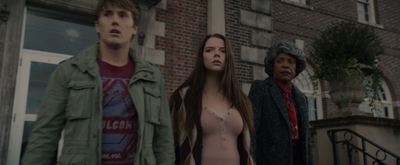 Shyamalan, his cinematographer Michael Gioulakis, and the rest of the creative team worked with FX company Powerhouse, originally based in Philadelphia, to achieve effects on Glass that will thrill audiences without taking them out of the movie. "I've had situations on other movies where I wasn't confident in the CGI team, so I kept looking at non-CGI answers," Shyamalan says. "But when you have a group like Powerhouse, you start to go, 'Hey, this is possible! That is possible!' It opens up a different way of thinking about it. They did just a wonderful job, and often with things that audiences will never even realise."
Shyamalan, his cinematographer Michael Gioulakis, and the rest of the creative team worked with FX company Powerhouse, originally based in Philadelphia, to achieve effects on Glass that will thrill audiences without taking them out of the movie. "I've had situations on other movies where I wasn't confident in the CGI team, so I kept looking at non-CGI answers," Shyamalan says. "But when you have a group like Powerhouse, you start to go, 'Hey, this is possible! That is possible!' It opens up a different way of thinking about it. They did just a wonderful job, and often with things that audiences will never even realise."
The Music
Go West
A Singular Sonic Score
All franchises, from Star Wars to Jurassic Park to Despicable Me have their signature musical themes. The music of the film is immediately recognisable and synonymous with the franchise itself. Glass may be the third part of a trilogy, but it's unlike any franchise ever made, and that presented Shyamalan and his composer West Dylan Thordson with an opportunity to create a score unlike any ever made, too.
"The music for Glass was a unique challenge, because we're making a sequel to two movies from two different generations, and one of the concomitant issues of that is that you're talking musical styles from two different generations," Shyamalan says. "Unbreakable was kind of an old-school Hollywood score. It's very unusual and has a great percussion kind of movement to it. It was cutting-edge at that time, but it's played by a 100-piece orchestra. The way we approached Split was sonically, with almost a Nine Inch Nails-y vibe. We were taking a cello sound and turning it and twisting it and bending it, and that was very cutting edge for now. So how do you bring these two approaches to one film?"
The solution was for Thordson to take the themes from Unbreakable, composed by James Newton Howard, and revise them in his own style and musicality. "It came out more minimalized, very, very, simple and stripped down with kind of the tones of West," Shyamalan says. They then used the musical themes from Split that Thordson had composed for that film. He also composed new themes specific to Glass. Finally, for flashback scenes from Unbreakable, they used the original score from that film.
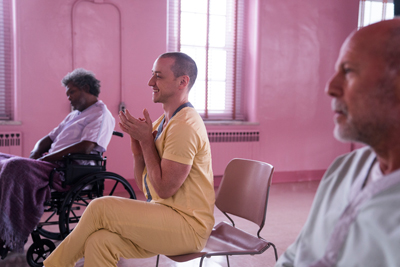 "It was an evolution," Shyamalan says. "West was on the movie for a good eleven months, I think. This was a really big commitment. He moved to Philadelphia, set up his stuff at our offices and at his home in Philadelphia, and just went for it. And he has a really unusual way of approaching it."
"It was an evolution," Shyamalan says. "West was on the movie for a good eleven months, I think. This was a really big commitment. He moved to Philadelphia, set up his stuff at our offices and at his home in Philadelphia, and just went for it. And he has a really unusual way of approaching it."
For one experiment, which wasn't ultimately used in the film, he recorded sounds at the Allentown State Hospital where the Raven Hill scenes were shot. "He would do incredible things with percussion," Shyamalan says. "He would go in and record all night after we finished shooting. At 4 a.m. he would be hitting drums and having a violinist come in and play, and it would echo in the auditorium and in the hallways and he would record it. Those sonic and intellectual and ineffable things make you feel that something in a scene is resonant."
Through the process of Split and Glass, Thordson and Shyamalan found that they are creative kindred spirits, in a way. "Authenticity is our main objective as filmmakers, and everything you hear in the movie is practically done by West," Shyamalan says. "It's created by him, synthesized and moved by him in some way. It's one man's tastes helping me tell my story, so you're getting these very strong, bold moves."
Release Date: January 17th, 2019
MORE





